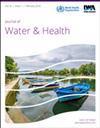过氧化氢预氧化作为一种策略,可增强光动力对耐甲氧西林金黄色葡萄球菌的抗菌作用
IF 2.5
4区 环境科学与生态学
Q3 ENVIRONMENTAL SCIENCES
引用次数: 0
摘要
抗菌光动力处理(aPDT)是一种基于光敏剂(PS)在分子氧存在下,在特定波长的光下激发的光氧化过程。这是一种很有前途的水和废水深度处理方法,特别是针对消毒挑战,如抗生素耐药细菌(ARB)。改进aPDT的研究一直在探索新的PS材料和添加剂。过氧化氢(H2O2)是一种广泛应用的消毒剂,主要用于食品工业和临床环境,在通常使用的浓度下,对环境的残留可以忽略不计,使其对水和废水部门友好。在这里,我们探讨了H2O2预氧化后使用姜黄素(一种天然PS)进行蓝光介导(450 nm) aPDT对耐甲氧西林金黄色葡萄球菌(MRSA)的影响。顺序处理的结果表明,在非常低的H2O2浓度下,aPDT效率略有下降,随后协同效应增加,直至有害点(CFU mL-1失活≥7 log10),表明预氧化和aPDT之间存在协同相互作用。h2o2预处理aPDT性能的提高鼓励了对辅助技术最佳操作条件的研究,并描述了使用所述策略解决ARB扩散问题的潜力。本文章由计算机程序翻译,如有差异,请以英文原文为准。
Hydrogen peroxide preoxidation as a strategy for enhanced antimicrobial photodynamic action against methicillin-resistant Staphylococcus aureus
Antimicrobial photodynamic treatment (aPDT) is a photooxidative process based on the excitation of a photosensitizer (PS) in the presence of molecular oxygen, under specific wavelengths of light. It is a promising method for advanced treatment of water and wastewater, particularly targeting disinfection challenges, such as antibiotic-resistant bacteria (ARB). Research in improved aPDT has been exploring new PS materials, and additives in general. Hydrogen peroxide (H2O2) a widely applied disinfectant, mostly in the food industry and clinical settings, present environmentally negligible residuals at the usually applied concentrations, making it friendly for the water and wastewater sectors. Here, we explored the effects of preoxidation with H2O2 followed by blue light-mediated (450 nm) aPDT using curcumin (a natural-based PS) against methicillin-resistant Staphylococcus aureus (MRSA). Results of the sequential treatment pointed to a slight hampering in aPDT efficiency at very low H2O2 concentrations, followed by an increasing cooperative effect up to a deleterious point (≥7 log10 inactivation in CFU mL–1), suggesting a synergistic interaction of preoxidation and aPDT. The increased performance in H2O2-pretreated aPDT encourages studies of optimal operational conditions for the assisted technology and describes potentials for using the described strategy to tackle the issue of ARB spread.
求助全文
通过发布文献求助,成功后即可免费获取论文全文。
去求助
来源期刊

Journal of water and health
环境科学-环境科学
CiteScore
3.60
自引率
8.70%
发文量
110
审稿时长
18-36 weeks
期刊介绍:
Journal of Water and Health is a peer-reviewed journal devoted to the dissemination of information on the health implications and control of waterborne microorganisms and chemical substances in the broadest sense for developing and developed countries worldwide. This is to include microbial toxins, chemical quality and the aesthetic qualities of water.
 求助内容:
求助内容: 应助结果提醒方式:
应助结果提醒方式:


